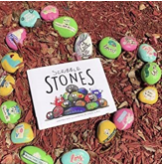Stones! Stones! Stones!
I am currently sitting at my dining room table at home, trying to do some work, but instead I find myself doodling on my notebook. I love to doodle, it’s probably the most creative outlet I have at the moment. I am a very creative person, having previously studied at art school, but I just haven’t allowed the time to evolve my art skills that I was once so obsessed about. Maybe I should dedicate some of my time stuck indoors to releasing my creative side again.
Creativity isn’t just about the freedom of self-expression and being artistic, it is also about the thought process, and how we respond to situations and tasks.
As an Early Years Teacher, I am a huge fan of fostering creativity and using anything ‘but toys’ to stimulate and develop a child’s creative mind. So, that made me think of what my top creative resource would be……STONES!
Stones are everywhere! I have a garden full of them (though they have significantly reduced in number due to using them frequently in nurseries). Stones offer so many possibilities and are an easy way to develop a child’s interest in natural materials and their surroundings. Stones come in all shapes, sizes, textures and colours.

(Lady the Ladybird stone)
I was recently working with a group of children who were exploring their local park. We were hunting for minibeasts, but unfortunately, we had no luck. We only found a few dead worms! I suddenly remembered that I had a ladybird stone that I made as a child (which is at least 20 years old). The next day, I brought it in for the children to explore and I couldn’t believe the hours of fun the children had creating stories in the park with Lady the Ladybird. They took their own photos to create a story book about Lady the Ladybird’s adventures. I have used stones as creative resource for years and so can you!
So, what can you do at home with all those stones in your garden?
Firstly, you need to establish some ground rules. Make sure your child knows how to play with stones safely (i.e. don’t put them in your mouth, always wash them first with hot soapy water, and do not throw them at anything or anyone).
- Go on a stone hunt. How many can you find? Can you sort the stones by size, colour, pattern, shape or texture? If there are stones that do not fit into any of their criteria, encourage your child to explain why.
- Stack stones – Can you balance stones on top of each other?
- Give your child the opportunity to simply play with stones – play with stones in water and sand, dig stones, bury stones. Encourage children to use them as props during play.
- Paint stones – you can create story stones based on your favourite storybook, write numbers and letters on them.
- Use stones to create pictures.
- Use stones to make marks on paper by dipping them in paint and rolling them on to the paper.
- Paint happy pictures on the stones and leave them on the path when you go out for your daily exercise to bring happiness to others.
 I also recently stumbled across a lovely story I had never heard of before called ‘Scribble Stones’ by Diana Alber.
I also recently stumbled across a lovely story I had never heard of before called ‘Scribble Stones’ by Diana Alber.  The story is about a little stone who is waiting to be chosen to become something amazing, but soon realises he has just become a boring paper weight. He eventually meets two characters called Scribble and Splatter and together they decide to pass on happiness and brighten someone’s day. It will truly make you smile and possibly spark an interest in playing with stones.
The story is about a little stone who is waiting to be chosen to become something amazing, but soon realises he has just become a boring paper weight. He eventually meets two characters called Scribble and Splatter and together they decide to pass on happiness and brighten someone’s day. It will truly make you smile and possibly spark an interest in playing with stones.
You can easily access it as a videobook on Youtube.
Stones can be anything! Enjoy hours of imaginative and creative fun!
Blog post written By Mandi Hayes.

